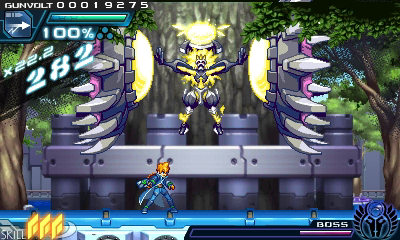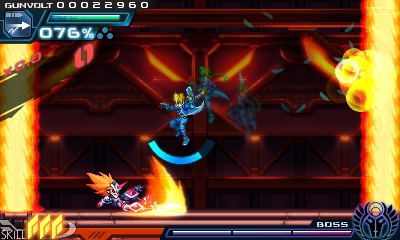Since Inafune left Capcom in 2010, all things related to Mega Man have pretty much been put on halt by Capcom (other than cameos). People have been clamoring for something new in the series while indie developers push titles that are similar in gameplay, some just re-skinned ripoffs, and others still that are more or less spiritual successors. If you’ve been missing the Boy in Blue (not Nic Cage), allow me to tell you a bit about Azure Striker Gunvolt.
The game takes a lot of inspiration from their (Inti Creates) previous titles, and that’s not a bad thing. For movement, you’ve got your typical left, right, up, down that you’d see in a platformer. Then you have your dash which you can combine with your jump, wall jump, and your electricity which allows you to glide (though it’ll make you fly at certain parts of a level). The level design is much more varied than you might expect, not only with backdrop or enemies, but the way in which you are allowed to approach situations. A level may have enemies that are drawn out and attack you when you try to electrocute someone, while another may require you to use electric currents to avoid missiles or move platforms. It’s not the coolest thing I’ve ever seen in a game, but it’s nice to see the mechanic isn’t limited to only combat.
While platforming is about half of this genre, the other is the enemies you must choose to either fight or bypass. The fighting in this game is definitely different from what you’ve played previously, and while it may seem like pausing to do damage would slow things down, that’s not the case at all (especially since you can still move while using electricity). An enemy can be shot for up to three tiers (depending on the weapon you have equipped, you may have more enemies available for damage). What I used for most of the game had a charge shot that went through enemies, but counted for one hit. It allowed for up to five tags, meaning I could have two enemies tagged, one with tier three and the other with tier two when I throw down the electricity. Or I could have five enemies at tier one, or any combination that adds up to five. This will build a bonus on your score, which will benefit your stage ranking. That’s good for reasons I’ll explain soon. Of course, you can’t just hold down the A or R button forever – you have a gauge that will run out. This will refill with time, or if you need it now, you can double tap down and you’ll recharge almost instantly. This will leave you vulnerable though, so you must choose what is best in your situation.

While you probably won’t use them until the bosses, you will also have skills at your disposal as you level up. Each one will use a different amount of Skill Points which regenerate over time. Skills vary from damaging attacks to healing, or even refilling your electricity. In some instances, this will be your saving grace in boss fights. It’s actually this that makes the game much easier. That, and I don’t believe the game actually has a consequence for dying. I died plenty of times against a couple bosses (Stratos and Nova) for one stupid reason – I didn’t change my tactics. I was so used to not using the L button for dashing that I didn’t even consider it as a way of dodging a particular move, but ended up figuring it out on my 4th try. You literally need to use L, because the move is instant death if you’re hit by it, and double tapping enough to adequately stay away from the pull is just going to break your 3DS. But in any case, I never saw a game over screen, nor did I see a life count. That being the case, the only real negative is losing your multiplier for score. The timer even restarts to where it was when you hit the checkpoint.
The length of an average level for me was eight to ten minutes my first time through (when you know what you’re doing, it’ll take about half the time). My final play time of the game was about 3.5 hours, though that could easily shoot up when going for higher scores, beefing up Gunvolt, and just bragging rights in general. A level usually consists of two acts, and then a boss. Of course there are exceptions, like the “boss rush” level, or a few others, but the majority of the game follows that rule. The ranking of a level will determine the amount of mystery boxes you can choose from – you can also boost this number by finding special items in the stage. While I’m not particularly fond of item farming, it’s hard to deny item synthesizing that changes the way you play a game. It’s a shame I was able to beat it with so little (I synthesized three things by the time I got to the last boss – I only managed to get the items to do so a couple levels prior to it), but I’ll definitely be spending more time with it in the future.

In regards to gear, there are several things you’ll be able to change. First and foremost, your weapon. That will determine how you proceed in levels – do you use the automatic that can hit three guys? Or do you go for something new you find? Do you lower damage, use air dashes, lower EP used… it’s up to you by changing your contact lenses, ring, and pendant. If you want to be hardcore, just take everything off. You don’t need it. You played enough NES games to handle yourself – while you’re at it, just skip all the checkpoints too. I may have said the game is easy, but the thing is, the things that make it that way are all optional. They make the game more accessible to those that aren’t used to games like this, and that’s great. My friends say they like the old school titles of this genre, yet they just don’t have the reflexes or patience to play/beat them. It’s no different from Shovel Knight in the sense that while the game doesn’t have a difficulty option on the menu, you choose it while playing the game.
While I’m a big fan of story, I’ve never really needed it in games like this. Sure, it’s nice to have, but if you make it optional, I’m probably going to forget about it. You start the game with the intent of destroying a computer, it turns out it isn’t a computer, and you leave your employer to save it as they don’t budge on the mission objective. You continue to do work for them as a freelance agent, and this person is eventually stolen from you, in which you must retrieve her. That’s what drives all the action when boiled down. The dialogue also gets rid of profanity by replacing it with non-words that sound similar. For example, there is a part where they say “horsejitt.” I don’t have a problem with clean dialogue, but this sort of thing makes me wonder why they didn’t just use the actual words. If you’re going to avoid it, it should be avoided entirely. Some of the dialogue in general bugged me, and I admittedly only read a couple of the stage briefings. One thing I regret not doing was speaking with Joule more, as it seemed as though when you spoke with her, your death wasn’t actually death. The reason everyone wants her is her power, which makes you near invincible, able to essentially fly, and just a force of mass destruction. It’s a really cool concept, though it would activate at random points, most notably the second to last level (she was abducted, so I wouldn’t think she’d be able to help me at that point).

The sprite work in the game is absolutely wonderful. While the shots that look like they’re from a visual novel are nice, the game world is much more appealing. Particularly the animations of the bosses and the transitions they are involved in, be it transformation or death. The music doesn’t stand out like something from Manami Matsumae would, but that’s not to say it’s bad. It works for the game, but it’s unlikely you’ll be humming it when you’re supposed to be falling asleep.
As mentioned in the preview article, if you buy this game within the first three months, you get a pretty rad addition: Mighty Gunvolt. This is a short title that takes levels and enemies from Azure Striker Gunvolt and downgrades them to an 8-bit level. If you wanted Mega Man, this is about as close as you can get without playing it. While there are only five levels, you can play as either Beck (Mighty No. 9, looks almost identical to Rock other than palette), Gunvolt, and Ekoro (Gal*Gun), and while you might think only the graphic would change, they actually have different movesets. I chose Beck originally, because why wouldn’t I? I paid an absurd amount of money to fund that Kickstarter, so of course I want to play as the character from that. He plays almost exactly how I expected, aside from the fact he has the dash as a charge move opposed to a charge shot. This can be problematic at first, but it can be extremely powerful once you get a feel for it. Gunvolt has a double jump as well as an electric charge attack, although it is quite limited in its usability, so he’s best for platforming. Ekoro can fly, and her main attack is charming the enemy to your side and attacking the enemy by either shooting or running right into them. The levels also hold areas that are only accessible to certain characters due to their abilities – so if you’re playing as Beck, don’t get frustrated by the pathway that’s too high for you with that fruit – you can slide into areas the others can’t make it through.

While Azure Striker Gunvolt is a very solid game on its own merits, the addition of Mighty Gunvolt only affirms my rating of this game. With its solid combat, fun platforming, beautiful styling, and fun upgrade system (oh, and I didn’t mention it earlier, but there are secrets to be found in both games – walls that can be broken or just walked through, though you won’t know it until you try it, usually), this game could only be worth the full price.
9 out of 10
Pros
- Solid Platforming/Combat
- Stage Ranking has Incentive
- Different Styles of Gameplay
Cons
- Convoluted (though mainly optional) Story
Azure Striker Gunvolt was created and published by Inti Creates and is available on the 3DS e-shop for $15 as of August 29, 2014. Mighty Gunvolt will be given to you for free if purchased before 9am PST on Friday, November 28th, 2014. If you’d like to see more, check out the official site.
Here at GBG we use a rating method that you are more than likely familiar with – a scale of 1 to 10. For clarification, we intend on using the entire scale: 1-4 is something you should probably avoid paying for; 5-7 is something that is worth playing, but probably not at full price; 8-10 is a great title that you can feel confident about buying. If you have any questions or comments about how we rate a game, please let us know.
Check out OpenCritic for a better idea of how our review stacks against others.